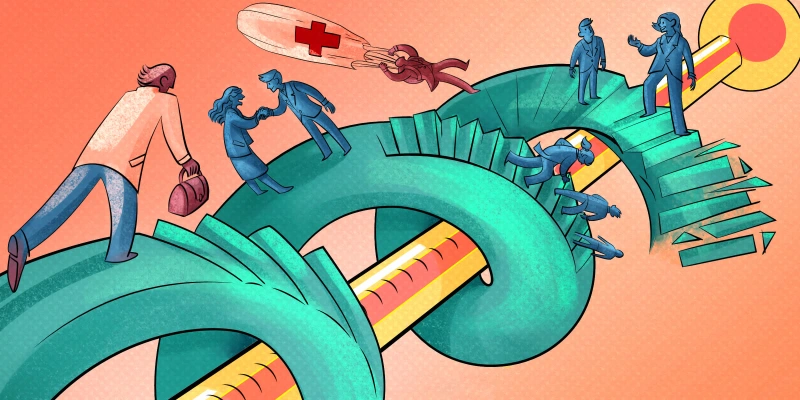Emergency physicians serve as the backbone of our nation’s health care safety net. Day or night, they stand ready to provide lifesaving care for anyone in need, regardless of insurance status or ability to pay. This commitment, rooted in the Emergency Medical Treatment and Labor Act, ensures that no patient is turned away in an emergency. Yet, despite their critical role, emergency departments across the country are strained by chronic underpayment and growing systemic challenges that threaten their very existence.
The Crisis of Chronic Underpayment
Emergency physicians are not compensated for more than 55% of the patient care they deliver. Over $5.9 billion in expected payments go entirely unpaid each year. This chronic underpayment is not merely a financial inconvenience; it is a systemic crisis with profound implications.
Physician Attrition and Burnout: The financial strain of uncompensated care contributes directly to high burnout rates and increasing attrition among emergency physicians. Many are forced to operate at a financial deficit while managing overcrowded EDs filled with high-acuity patients. This unsustainable model is driving experienced physicians out of clinical practice, leading to early retirements and transitions to non-clinical roles. The result is a workforce stretched thin as demand for emergency care continues to rise.
Resource Limitations and Compromised Care: Chronic underfunding restricts EDs from staffing adequately or equipping for patient surges. This results in longer waiting times, limited availability of critical interventions, and delays in care that put patient outcomes at risk.
Impact on Training and Education: Academic EDs are particularly vulnerable, as financial strain reduces the resources available to train the next generation of emergency physicians. This threatens the pipeline of skilled professionals desperately needed to meet future demand.
Increased Reliance on Locum Tenens Physicians: To fill staffing gaps, many hospitals turn to locum tenens clinicians. This stopgap measure is costly and disrupts continuity of care, further straining emergency services.
Declining Reimbursement Rates and Skyrocketing Non-Emergent Visits
From 2018 to 2022, emergency physician payments dropped by 10.9% for in-network visits and nearly 48% for out-of-network care. Recent reports indicate that this decline has continued through 2023 and 2024, further squeezing emergency care resources. Compounding this issue is the surge of non-emergent patient visits — individuals turning to the ER because primary care is either inaccessible or unaffordable. Emergency physicians are expected to bypass insurance preauthorization for advanced testing, driving up costs and leading to overcrowded EDs.
The Reality of Overcrowding and Boarding: As primary care becomes harder to access, patients increasingly rely on EDs as their safety net. This surge has led to severe overcrowding, with admitted patients often boarding in hallways for days before a bed becomes available. This backlog strains emergency staff and compromises patient care.
Administrative Burdens and Misaligned Metrics: Emergency physicians are burdened with excessive documentation requirements for EHRs and quality metrics that do not reflect the realities of emergency care. Current CMS expectations add to the strain, increasing burnout and litigation risks for already overextended clinicians.
The Aging Population and Escalating Complexity: Our aging population presents with multiple comorbidities, demanding more intensive evaluations and longer treatment durations in emergency settings. EDs are stretched thin, attempting to meet the growing complexity of care with fewer resources.
Workplace Violence: An Unseen Epidemic: While providing lifesaving care, emergency physicians also face rising rates of workplace violence. This adds yet another layer of risk and stress, contributing further to burnout and workforce attrition.
Call to Action
To address these critical challenges and safeguard the future of emergency medicine, immediate and decisive action is needed:
Reimbursement Reform: Adjust government and commercial rates to reflect the true costs of emergency care. Addressing the $5.9 billion in unpaid services is crucial for sustainability. Federal and state-level safeguards should be introduced to prevent emergency physicians from operating at a financial deficit.
Combat Physician Attrition and Burnout: Implement federal and state incentives, including loan forgiveness, enhanced reimbursement for high-acuity care, and mental health support programs. Addressing burnout is essential to sustain the emergency workforce that communities rely on.
Resource Expansion and Staffing Support: Allocate federal and state funding to improve ED staffing, manage surges in patient volume, and reduce wait times. Adequately staffed EDs improve patient outcomes and reduce workforce strain.
Support for Training and Education: Increase funding for academic emergency medicine programs to ensure the pipeline of skilled practitioners remains strong. Future generations of emergency physicians must be equipped to meet growing demand.
Limit Overreliance on Locum Tenens: Incentivize long-term staffing solutions that promote continuity of care and reduce dependency on temporary clinicians.
Reduce Non-Emergent ER Visits: Expand primary care access and incentivize urgent care utilization for non-emergent cases, alleviating ED overcrowding.
Resolve Overcrowding and Boarding: Advocate for policies that streamline hospital admissions and discharges, improve inpatient flow, and decrease prolonged boarding times.
Reduce Administrative Burdens: Streamline EHR documentation and reform CMS quality metrics to align with the realities of emergency medicine practice.
Support for the Aging Population: Allocate targeted funding to better manage elderly patient care in emergency settings, reducing bottlenecks and optimizing care delivery.
CMS Metric Reforms: Advocate for CMS policy adjustments that recognize the unique challenges of emergency care, reducing unrealistic expectations that contribute to physician burnout and litigation risk.
Workplace Safety Initiatives: Introduce federal protection and enhanced security measures to safeguard health care workers from violence.
Emergency medicine stands at a crossroads. Chronic underpayment, overcrowding, and rising administrative burdens are pushing the nation’s health care safety net to its breaking point. If we fail to act, the ripple effects will be felt in every community. Policymakers must prioritize emergency medicine reform — because when EDs falter, patient lives are at risk.
How will you fight for ED reform? Share in the comments.
Dr. Elias Said is a residency-trained and board-certified emergency medicine specialist with over 30 years of experience with emphasis on the latest evidence-based practice and local/national involvement in the advancing of specialty care in the areas of critical care, stroke identification and management, critical aspects of cardiovascular diseases, ultrasonography application in emergency medicine, and administrative management of any size emergency department.
Image by Fanatic Studio / Getty Images







